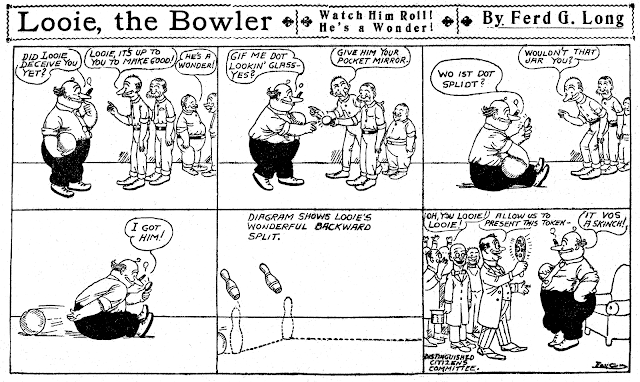Saturday, February 18, 2023
Herriman Saturday: May 17 1910
May 17 1910 -- The boxing world has not come to a standstill while awaiting the Fight of the Century. Lew Powell and George Memsic are set to meet in the ring on the 21st. It's not a championship fight, but Memsic and Powell are both famous enough fighters that there's plenty of interest.
As Herriman's cartoon shows, many luminaries are in town to see the fight, including promoter Tom McCarey, fighters like Jeff Perry and England's Owen Moran, and actor DeWitt Van Court.
Labels: Herriman's LA Examiner Cartoons
Friday, February 17, 2023
Ink-Slinger Profiles by Alex Jay: Aldo Rubano
Labels: Ink-Slinger Profiles
Wednesday, February 15, 2023
Mystery Strip: The March of Science
Here's a strip that seems like it ought not to be mysterious. The March of Science was apparently a weekly strip offering of Science Service, with my only examples (above) from mid-1937. Now I will grant you that Science Service isn't exactly King Features, but they were a well-respected smaller syndicate that specialized in distributing science news and offering columns and inforgraphics on scientific subjects. Yes, a strip is a little off their regular radar, but it seems like a natural for them, and with their other material pretty popular, you'd think this strip would have attracted some clients.
However, beyond the two examples above, found in a small Virginia weekly paper, I cannot find any other evidence that this feature ever existed. Nothing on newspapers.com, nothing in E&P. Technically I can list a feature with as little as two known examples, but I would like to hold out for better data on this feature that SEEMS like it ought to be slightly less rare than teeth on a chicken.
If you have any examples of this feature in your collection, or can run some online searches at other archives, please let me know if you find anything!
Labels: Mystery Strips
"Hudson started his career at the Columbus Citizen in 1924, then worked at The Toledo Blade and the Cleveland News."
https://centennial.societyforscience.org/entry/1920s-syndication-broadens-science-services-reach/
Monday, February 13, 2023
Obscurity of the Day: Looie the Bowler
Before daily comics became a metronomic list of the same titles every day of the year in your paper, you never knew from day to day what might show up. There were still series, but a given series might go on for a few days, a few weeks, or for years. It all depended on the series. Take Looie the Bowler for instance. The idea of a guy who speaks broken English and can make amazing trick bowling shots is great fun, but it has a very limited natural lifespan. And that was just fine in 1909 when cartoonists were freer to come up with new concepts and drop old ones once the humour had been wrung out. We've lost so much by tying our great cartoonists down, slaving over the same set of characters in the same situations year after year after year. Imagine what they could come up with if they had the freedom to jump around among subjects and characters to their hearts' content!
But I digress. Looie the Bowler ran on occasional weekdays from January 25 to June 11 1909, penned by that workhorse of the New York Evening World, Ferd Long. Ferd was a tremendously funny guy, but evidently never quite got the hang of logical panel placement (see upper sample).
Labels: Obscurities
I presume the proper order is (1-2) the two small panels at upper left (3-4) the tall panels in the middle (5) the upper right panel (6) the lower left panel and (7) the lower right panel.
It doesn't help that the one pin left standing, the one Looie knocks down to make his spare, isn't shown in (5)...or is it a printing error and that blemish is where the pin was supposed to be?
Sunday, February 12, 2023
Wish You Were Here, from Dwig
Here's a card from Dwig's School Days series, aka Raphael Tuck Series 170, which seems to have been produced sometime between 1907 and 1910. These Tuck cards are top-notch productions with embossing and metallic ink, both features I cannot reproduce for you effectively on your screen.
Labels: Wish You Were Here







